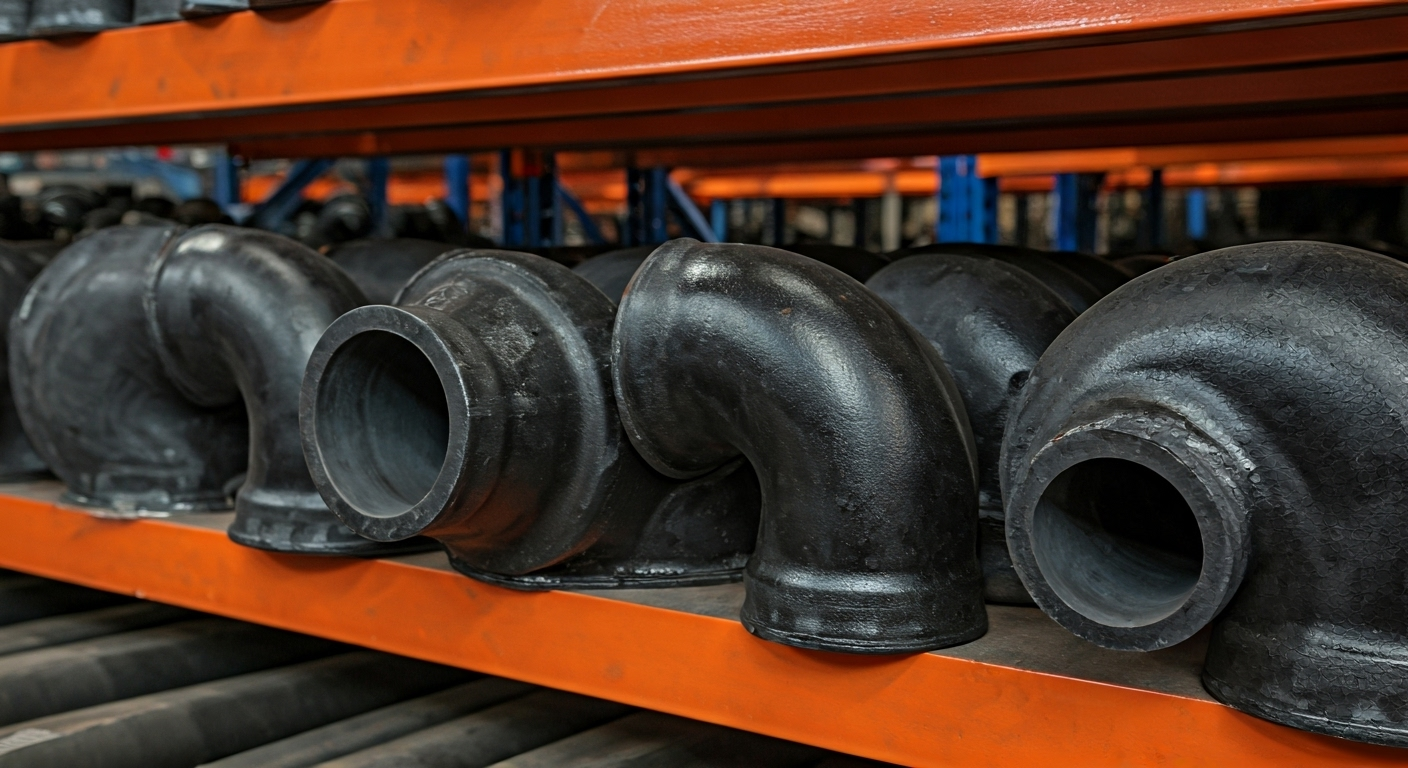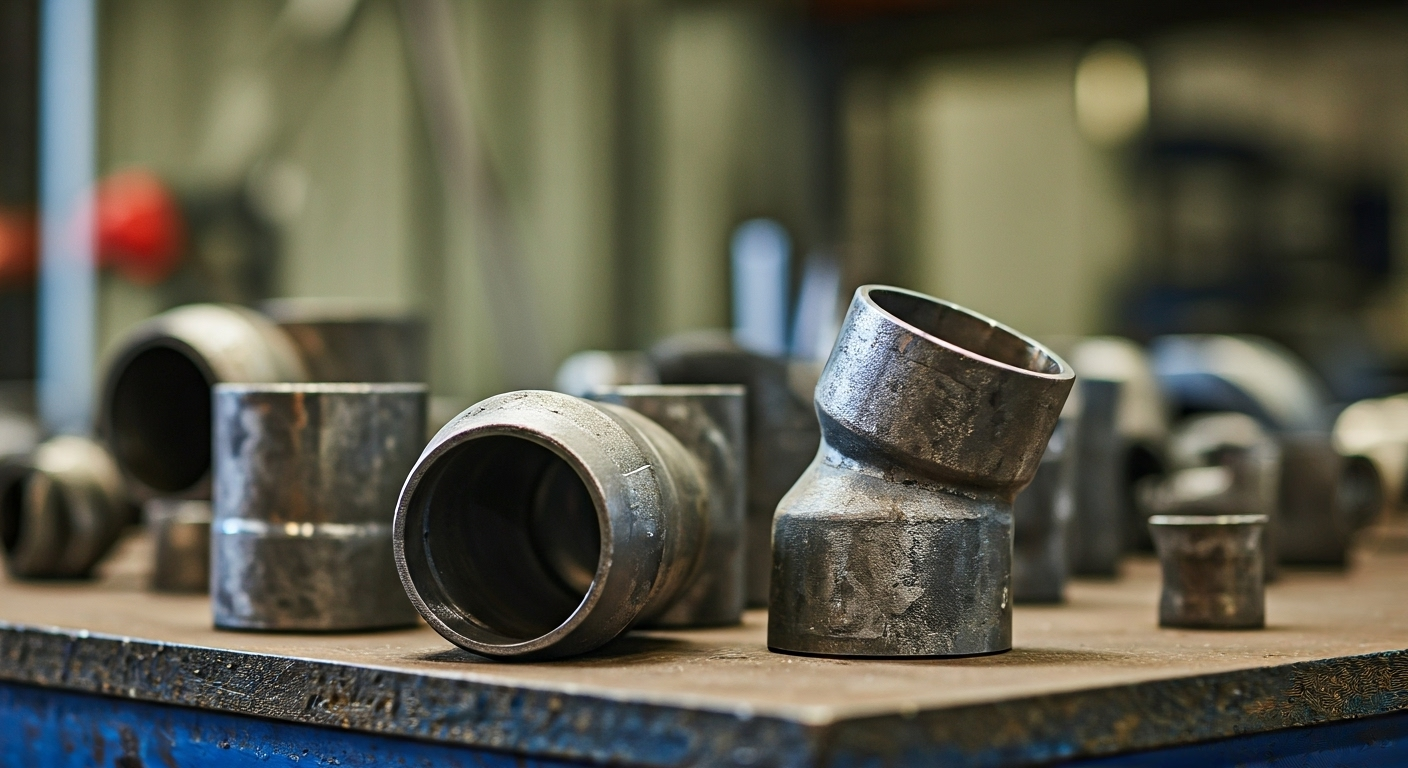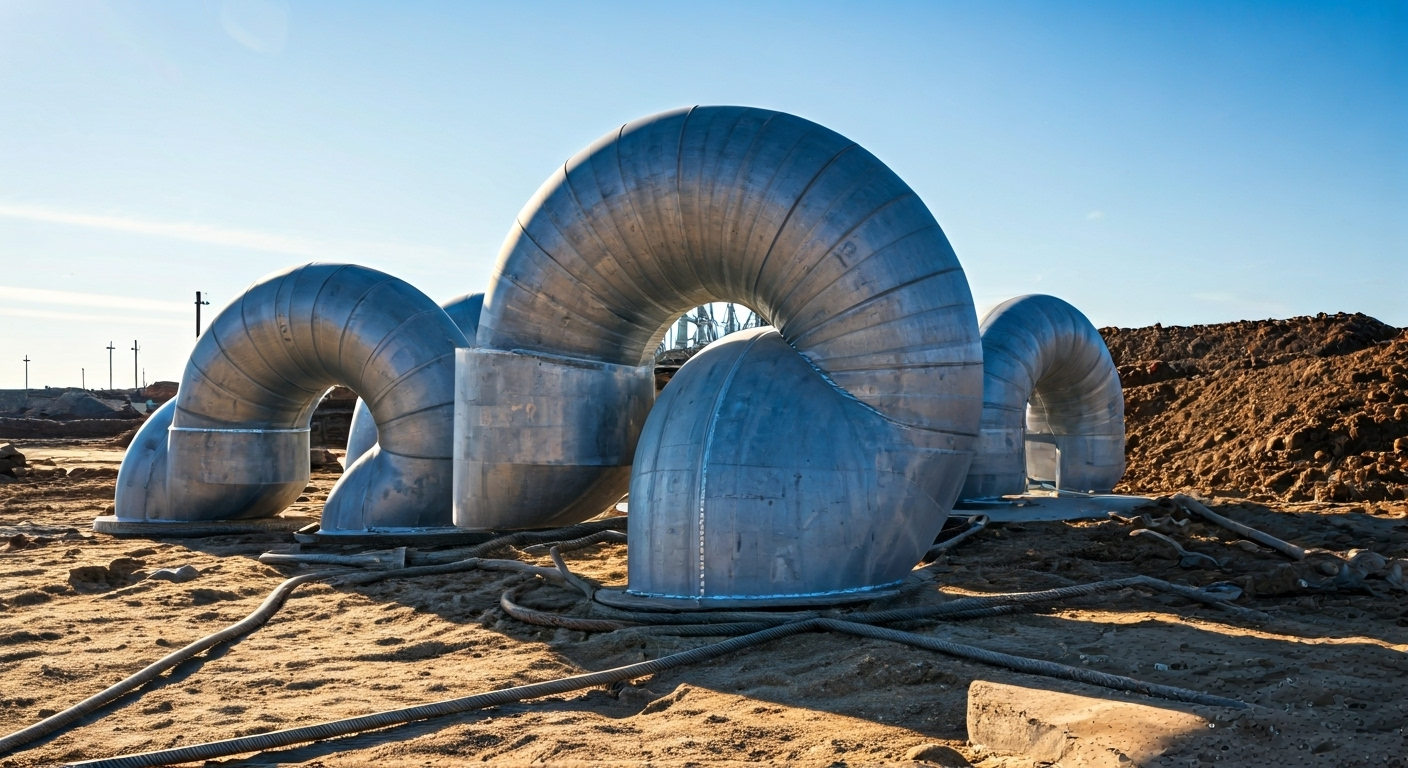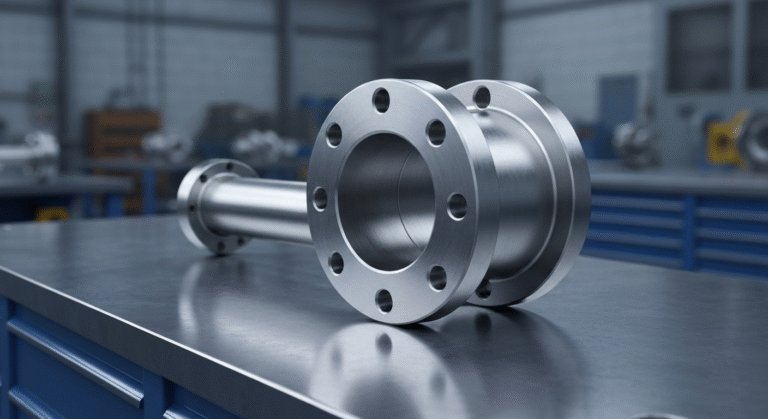-
Zona industrial de Yinzhuang, concelho de Mengcun, cidade de Cangzhou, província de Hebei, China

Código de tubo de aço: Tipos e aplicações essenciais
Cotovelo de 90 graus de aço carbono pintado de preto com um raio de curvatura de 5D estão no armazém

Principais destaques
- Os cotovelos para tubos de aço são componentes críticos utilizados para alterar a direção do fluxo em sistemas de tubagem, garantindo um movimento suave do fluido em projectos complexos.
- Vários materiais, como o aço inoxidável, o aço-liga e o aço-carbono, oferecem durabilidade e resistência à corrosão para satisfazer os requisitos da indústria.
- Os cotovelos existem em diferentes ângulos - 45°, 90° e 180° - cada um adaptado a aplicações específicas com base no raio de curvatura e nas necessidades de fluxo.
- As indústrias chilenas utilizam extensivamente cotovelos de aço no transporte de fluidos, na construção e em sistemas de tratamento de águas residuais.
- A conformidade com normas como ASME e ANSI garante cotovelos de alta qualidade, fabricados com precisão para ambientes exigentes.
Introdução
Os cotovelos para tubos de aço, chamados "codo de acero", são peças muito importantes em todos os sistemas de tubagem, incluindo o tubo de caldeira. Alteram a forma como o fluxo se processa, mas mantêm o tubo forte. Pode ver estes codos em muitos locais, como edifícios e empresas que utilizam petróleo e gás. Estas peças ajudam a mover os líquidos ou o gás nos tubos.
As peças do Codo de acero são fabricadas em diferentes tipos de materiais. Algumas são feitas de liga de aço, outras de aço inoxidável e outras de PVC. Existe um codo producto para cada necessidade, desde trabalhos de alta pressão a espaços apertados.
Com esta mistura de peças de codo, acero e pvc, as pessoas podem utilizá-las em muitos trabalhos. É evidente que estas peças de tubos são necessárias no trabalho moderno da construção e da indústria.
Tipos de códigos de tubo de aço

Os cotovelos para tubos de aço existem em muitos tipos e tamanhos para satisfazer diferentes necessidades. Pode obtê-los numa variedade de ângulos, níveis de espessura e tamanhos como 1D ou 5D de raio. Estes elementos podem alterar a forma como o ar flui e a pressão existente no tubo. Os cotovelos são feitos de materiais resistentes. Podem ser de liga de aço, aço-carbono ou aço inoxidável. Isto ajuda-os a resistir à ferrugem e a durar muito tempo.
Estes cotovelos são fabricados com muito trabalho e cuidado. Cumprem as normas asme e ansi, pelo que pode utilizá-los mesmo em locais difíceis com alta pressão. Estes cotovelos funcionam bem com muitos tipos e tamanhos, pelo que são necessários em muitos sistemas de tubagem grandes e complicados.
Códigos de 45°, 90° e 180°: Diferenças claras
Os cotovelos de aço distinguem-se pela forma da sua curva e pela forma como são utilizados. Vejamos em que é que eles são diferentes:
Tipo | Raio de curvatura | Aplicações |
|---|---|---|
Código de 45° | Raio mais pequeno | Sistemas AVAC, pequenos ajustes angulares |
Código de 90° | Raio padrão | Sistemas industriais, condutas de águas residuais |
Código de 180° | Raio maior | Reencaminhamento de fluidos, construção naval |
O codo de 45° é a melhor escolha quando são necessárias pequenas mudanças de direção. Permite-me ajustar o fluxo com bom controlo e não prejudica a forma como os fluidos se movem. O codo de 90° funciona bem para curvas rápidas ou acentuadas. Assegura que os tubos se ligam da forma pretendida em sistemas que necessitam de um ângulo forte. O codo de 180°, por vezes chamado de curva em U, é útil quando se tem de voltar o fluxo todo para trás em espaços apertados. Também impede coisas como saliências ou quedas extra na forma como as coisas fluem. Cada codo responde a uma necessidade diferente e pode manter um sistema a funcionar com menos problemas ou reparações.
Materiais mais comuns e suas vantagens
A escolha do material é muito importante para a forma como os cotovelos de aço funcionam. Os tipos mais comuns que encontrará são o aço inoxidável, o aço-liga e o aço-carbono. Eis o que cada um deles pode fazer por si:
- Aço inoxidável: Combate muito bem a ferrugem, pelo que funciona muito bem em locais à beira-mar ou com produtos químicos.
- Liga de aço: É resistente e pode suportar tanto o calor elevado como a pressão forte.
- Aço carbono: É menos dispendioso e é forte, pelo que muitas indústrias utilizam-no muito.
Todos estes materiais ajudam um cotovelo de tubo a ser forte, a durar mais tempo em diferentes tipos de clima e a lidar com o trabalho árduo em locais difíceis. Algumas ligas, como o aço à base de níquel, podem ajudar os cotovelos a durar ainda mais tempo. Quando utiliza estes materiais em conjunto num sistema de tubagem, pode ver como são importantes para obter os melhores resultados.
Aplicações principais na indústria chinesa

No Chile, os cotovelos de aço desempenham um papel importante nos sistemas de tubagem utilizados em muitas indústrias. Ligam tubos de pvc e outras peças de aço, o que ajuda a manter o fluxo estável e faz com que a instalação dure mais tempo. Indústrias como a petroquímica, a mineira e a de tratamento de águas residuais necessitam de acessórios soldados, tais como tope de acero e acessórios de aço resistentes para os seus sistemas.
Estes cotovelos são também utilizados em grandes projectos de infra-estruturas, bem como nas indústrias alimentar e farmacêutica. Funcionam bem com configurações de alta pressão, pelo que se adaptam às necessidades de trabalhos difíceis. Isto mostra como o acero e o tope de acero são importantes na engenharia moderna atual.
Utilização em sistemas de condução de fluidos
Os cotovelos para tubos de aço são importantes na forma como o fluido se move e na pressão encontrada nos sistemas de transporte de fluidos. Estas peças ajudam a gerir para onde vai o fluxo. São fabricados com uma atenção cuidada ao "rádio de curvatura", ajudando cada sistema a funcionar no seu melhor.
São utilizados muitos ângulos, como 45°, 90° e 180°. Os cotovelos de 45° funcionam bem quando é necessária apenas uma pequena mudança de direção. Os cotovelos de 90° e 180° são úteis para curvas mais acentuadas ou em espaços pequenos. No que diz respeito aos materiais, o aço inoxidável oferece mais "resistência". Isto ajuda a evitar que as peças se desgastem demasiado depressa.
Em alguns sistemas, as coisas tornam-se difíceis com o fluido a mover-se rapidamente e pode haver perda de energia. Os cotovelos ajudam a travar algumas destas perdas e a tornar as coisas mais suaves. Para manter tudo seguro e sólido, os fabricantes seguem normas como a ASME. Ao construir da forma correta, as ligações em cotovelo mantêm o fluxo e o desempenho no seu melhor.
Relevância em infra-estruturas e construção
Os cotovelos de aço são muito importantes na construção e noutros trabalhos de infra-estruturas. Podem ser utilizados para alterar a forma como os líquidos passam nos tubos e para lidar com fortes pressões. É por isso que são necessários em muitos sítios. Os acessórios compatíveis com as normas ANSI, como os tipos de liga e de aço inoxidável, ajudam a satisfazer as necessidades dos novos edifícios.
As pessoas utilizam estes cotovelos de aço em condutas de água subterrâneas, em instalações de AVAC e para drenar a água. Os cotovelos afectam o bom funcionamento dos sistemas e ajudam a manter tudo seguro. Os materiais resistentes dos cotovelos de aço significam que não haverá muito para reparar ou substituir. Fazem um bom trabalho e duram muito tempo, mesmo quando as coisas se tornam difíceis.
É possível encontrar cotovelos de aço em projectos como a construção de pontes ou outras obras de grande dimensão. Estas peças não ajudam apenas a movimentar corretamente os líquidos. Mantêm a sua construção sólida e ajudam os materiais a durar mais tempo.
Conclusão
Em suma, os cotovelos para tubos de aço, incluindo a curva de 180°, são peças-chave utilizadas em muitos trabalhos industriais. Proporcionam formas fáceis e flexíveis de mover fluidos e construir estruturas fortes. Conhecer os diferentes tipos, como os cotovelos de 45°, 90° e 180°, e os materiais utilizados, é importante quando se pretende escolher o mais adequado para o seu projeto. Estes cotovelos, feitos de acero, também desempenham um papel importante nas infra-estruturas no Chile, mostrando a sua importância na construção e noutras áreas. Se quiser saber mais sobre como escolher o melhor codo para as suas necessidades ou se quiser ver as suas utilizações especiais, pode falar com os nossos especialistas e obter uma consulta gratuita.
Perguntas mais frequentes
Qual é a vida útil de um tubo de aço?
Os cotovelos para tubos de aço duram muito tempo devido ao seu material forte e à sua elevada "resistência". Se utilizar aço inoxidável ou liga, estes podem manter-se bons durante muitos anos. Podem mesmo durar décadas. O tempo de vida também depende dos "grados" necessários para o trabalho e do local onde são utilizados. Para tirar o máximo partido destes cotovelos, certifique-se de que faz a manutenção adequada ao seu projeto ou trabalho.
Como escolher o tipo de código adequado para o meu projeto?
Escolha com base no tamanho da "unidad", no "radio de curvatura" e na forma como pretende que o fluido "flua". Utilize as regras ANSI e ASME para encontrar as opções corretas, incluindo os estilos acero al carbono. Também deve pensar em aspectos como a pressão, a temperatura e as necessidades do projeto. Isto ajuda a garantir que obtém o melhor "codo de acero" para o seu trabalho.
Que normas regulam os códigos de aço no Chile?
No Chile, os cotovelos de aço inoxidáveis são fabricados de acordo com as normas ASME, ANSI e DIN. Estas normas ajudam a garantir que o codo de acero é seguro e bem construído. As especificações para coisas como a costura e a curvatura do codo têm de passar nos controlos das autoridades. Isto é para garantir que o codo de acero pode fazer o seu trabalho da maneira correta.
Existem diferenças entre os códigos soldados e roscados?
Sim, os "accesorios de soldadura" proporcionam uma junção suave e apertada, mas é necessário ter conhecimentos de soldadura para os utilizar. Os cotovelos roscados são simples de utilizar e fáceis de colocar no sítio. A qualidade da "costura" e a "resistência" que obtém variam consoante as necessidades do trabalho, pelo que deve escolher cotovelos roscados ou soldados para o seu projeto.
Que tipo de manutenção requerem os códigos de aço?
Os cotovelos de aço necessitam de "manutenção" regular. Deve verificar a sua resistência, ferrugem e sinais de danos. O aço inoxidável é resistente, pelo que não necessita de muitos cuidados. Os acessórios de aço-carbono, no entanto, precisam de ser verificados periodicamente quanto à sua "resistência" para se manterem a funcionar bem.


